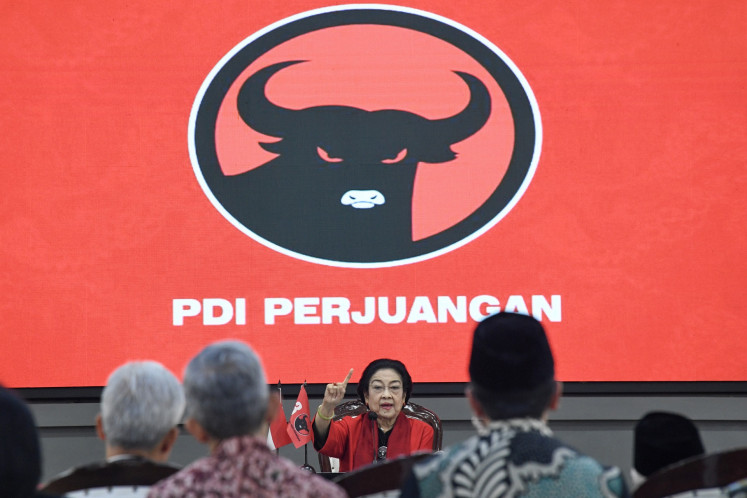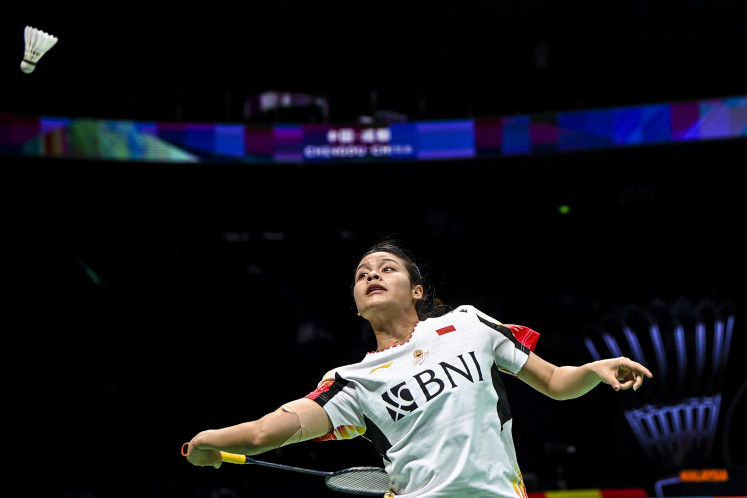Ceremony 60: Harmony in brush strokes
Swift strokes of the brush and deep philosophical thinking come together to create beautiful Chinese brush paintings, while Balinese traditional artworks marry artists’ vision of nature and community with an intricate play of color
Change Size

S
wift strokes of the brush and deep philosophical thinking come together to create beautiful Chinese brush paintings, while Balinese traditional artworks marry artists’ vision of nature and community with an intricate play of color.
Balinese esthetics: Visitors take a look at Balinese traditional paintings, which marry the artists’ vision of nature and community with an intricate play of color. JP/Ricky Yudhistira
While Balinese and Chinese paintings have their own distinct characteristics, in essence, they share a philosophy of life: harmony.
“Harmony is a keyword in the Chinese civilization,” says Fan Chuangeng, a senior project manager at the Chinese International Exhibition Agency. The Balinese, meanwhile, observe the Hindu concept of harmony, Tri Hita Karana, which the community has adopted for hundreds of years.
Visual art from these different parts of the world is now on display at the National Gallery, Central Jakarta, in an exhibition titled “Ceremony 60”.
The exhibition, one of many events organized this year to celebrate the 60th anniversary of relations between Indonesia and China, runs until tomorrow evening.
Entering the gallery, visitors are greeted by Early Spring in the Southern Part of the Yangtze River, a picture by artist Song Wenzhi showing rows of houses with pretty pink cherry blossom trees bordering a river. Further in the gallery, one is transported to the world of great Chinese landscapes, flowers and birds, and small wonders like small insects and crustaceans.
Visitors will also be able to enjoy masterpieces from the traditional Balinese school of painting, depicting the dynamics of the island’s communal life.
According to Curator Agus Dermawan T., China’s influence on Balinese art can be seen in the Balinese artists’ use of Chinese ornamental motifs in their paintings. The exhibition, however, does not only aim to present traditional Balinese paintings influenced by China. The theme “Bali: Nature and Figuration”, Ade says, presents Balinese paintings focusing on nature, community activities, arts performances, legends, myths, daily lives and religious rituals.

The work of the late Anak Agung Gde Sobrat, one of Bali’s most prominent 20th century painters, brings Balinese dances and markets to life, in Penari Legong and Pasar di Kampung. Both paintings highlight how Balinese artists have a gift for meticulously observing the human body, with Pasar di Kampung depicting a skinny and tanned vegetable seller surrounded by lean women carrying products on their head.
Dewa Putu Mokoh’s more playful style shines in another corner of the exhibition. In Berenang-renang (swimming), he paints boys swimming in a creek by a big banyan tree, against a background of Balinese gates and houses.
Bali’s complex cultural dynamics and the communal aspect of Hindu religious life come to life in Made Budi’s Tari Kodok (Frog Dance). Tari Kodok, a colossal Balinese-style painting, brings together traditional and contemporary characters going about their daily activities: the police, surfers, a woman carrying offerings on her head, dancers and fishermen.
Chinese and Balinese paintings hardly ever come together under one roof, let alone in Jakarta.
According to China’s ambassador to Indonesia Zhang Qiyue, Chinese people rarely get the opportunity to admire these paintings in their home country. “I’ve only seen a few myself,” she said.

The Chinese brush painting section of the exhibition, under the theme “Serenity and Harmony”, comprises 50 works of art, all painted using a 1,000-year-old watercolor painting technique.
Three of painter Qi Baishi’s works are on display. Baishi, a master in Chinese painting, specializes in small insects and shrimps as well as fruit, vegetable, and flowers.
Group of Shrimps, one of Baishi’s most famous works, shows how adept the artist is at using the Chinese brush painting technique and depicting the anatomy of a shrimp. His skillful strokes create an intricate cluster of shrimps, whose antennas brush against each other. His dark and dense ink emphasizes the crustacean’s hard shell.
Yin explained there was no room for error in the painting. “Many students have tried to copy this painting. They can paint the body but the antennas are the hardest part,” he said.
Baishi, in Perpetual Peace, paints a simple image of a black chicken floating above a basket of apples, which according to Yin, could also be seen as a pictograph for the phrase “Peace for generations”.
Many of the Chinese works combine painting and poetry, a technique pioneered by poet and painter Wang Wei. Yin said most of the painters have to be good in poetry. “You need to. If you want to study Chinese brush paintings, you have to have a lot of knowledge of Chinese history and literature,” he said, adding that it took a long time to become a master in brush painting.
Tall protruding mountains surrounded by misty clouds, like Wei Xi’s Cloud Flowing in Yuping Mountain, also feature prominently in the exhibition.
According to Yin, many artists have attempted to put on canvas the beauty and greatness of central China’s Yuping Mountain.
Other Chinese paintings in the exhibition include works by Wu Changshuo, Lin Fengmian, Li Keran and Li Kucan. Contemporary works by Wu Guanzhong, Wang Mingming and Shi Chuan are also on display.
Gallery visitor Irawati Batangtaris from the Indonesian Heritage Trust said she was amazed by the refined paintings in the exhibition.
“It makes one want to go inside the mind of the masters,” she said of Baishi’s Group of Shrimps.
ceremony 60
Until tomorow
National Gallery
Jl. Merdeka Timur No. 14
Central Jakarta









